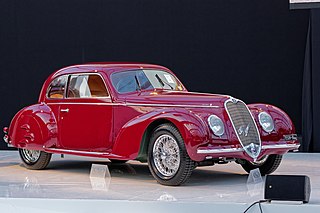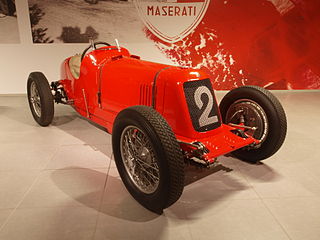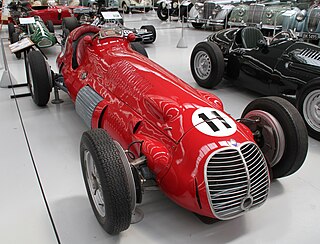
English Racing Automobiles (ERA) was a British racing car manufacturer active from 1933 to 1954.

The Bugatti Type 51 series succeeded the famous Type 35 as Bugatti's premier racing car for the 1930s. The main distinction is that it uses a twin cam engine. Unlike the dominant Type 35s of the prior decade, the Type 51 were unable to compete with the government-supported German and Italian offerings.

The Maserati 450S is a racing car made by Italian automobile manufacturer Maserati for participating in FIA's endurance World Sportscar Championship racing. A total of nine were made.

Maserati A6 were a series of grand tourers, racing sports cars and single seaters made by Maserati of Italy between 1947 and 1956. They were named for Alfieri Maserati and for their straight-six engine.

The Maserati 200S is a racing car made by Italian automobile manufacturer Maserati as a successor to the Maserati A6GCS. 28 cars were made in total. The development of the 200S, codenamed Tipo 52 started in 1952, led by Vittorio Bellentani. In response to Ferrari's 500 Mondial racing car which featured a four-cylinder engine and was quite successful in sports car racing. The car had a 1,994.3 cc (2.0 L) inline-four light-alloy engine, featuring dual overhead valves per cylinder and twin camshafts, double Weber 50DCO3 or 45DCO3 carburetors. The engine was rated at 190 PS at 7,500 rpm. Many chassis components were identical to the Maserati 150S in order to speed up development, except the rigid rear axle inherited from the Maserati A6.

The Maserati Tipo 151 is a racing car manufactured by Italian automobile manufacturer Maserati for the 1962 LeMans season to compete in the experimental GT car class. Three cars were built in total, one for Johnny Simone of Maserati France with a red exterior colour and white tri-stripes whilst two were built for Briggs Cunningham for his racing team. These cars had a white body with two blue stripes.

The Maserati Tipo 60/61 are a series of sports racing cars produced between 1959 and 1961 by Italian automobile manufacturer Maserati for privateers racing in sports car events including the 24 Hours of Le Mans in the 2-litre and 3-litre racing category. It used an intricate tubular space frame chassis, containing about 200 chro-moly steel tubes welded together, arranged triangular formation at high stress areas of the chassis, hence the nickname "Birdcage". This method of construction provided a more rigid and, at the same time, lighter chassis than other racing cars of the time.

The Alfa Romeo 6C name was used on road, race, and sports cars produced between 1927 and 1954 by Alfa Romeo; the "6C" name refers to the six cylinders of the car's straight-six engine. Bodies for these cars were made by coachbuilders such as James Young, Zagato, Touring Superleggera, Castagna, and Pinin Farina. Beginning in 1933 there was also a 6C version with an Alfa factory body, built in Portello. In the early 1920s Vittorio Jano received a commission to create a lightweight, high performance vehicle to replace the Giuseppe Merosi designed RL and RM models. The car was introduced in April 1925 at the Salone dell' Automobile di Milano as the 6C 1500. It was based on Alfa's P2 Grand Prix car, using a single overhead cam 1,487 cc in-line six-cylinder engine, producing 44 horsepower. In 1928 the 1500 Sport was presented, which was the first Alfa Romeo road car with double overhead camshafts.

The Maserati 4CL and its derived sister model the Maserati 4CLT are single-seat open-wheel Grand Prix racing cars that were designed and built by Maserati. The 4CL was introduced at the beginning of the 1939 season, as a rival to the Alfa Romeo 158 and various ERA models in the voiturette class of international Grand Prix motor racing. Although racing ceased during World War II, the 4CL was one of the front running models at the resumption of racing in the late 1940s. Experiments with two-stage supercharging and tubular chassis construction eventually led to the introduction of the revised 4CLT model in 1948. The 4CLT was steadily upgraded and updated over the following two years, resulting in the ultimate 4CLT/50 model, introduced for the inaugural year of the Formula One World Championship in 1950. In the immediate post-war period, and the first two years of the Formula One category, the 4CLT was the car of choice for many privateer entrants, leading to numerous examples being involved in most races during this period.

The Maserati 8CM is a Grand Prix race car produced by Italian manufacturer Maserati in Bologna between 1933 and 1935.

The Maserati 250S, and its derivative and version, the 250 Sport, are sports racing cars, designed, developed and built by Italian car manufacturer Maserati, between 1954 and 1957. Only two models were produced.

The Maserati 150 GT was a prototype sports car produced by Maserati in 1957. Derived from the four-cylinder Maserati 150S race car, it was a singular road-going example, and was given spyder bodywork.

The Ferrari 412 S was a unique sports racing car produced by Ferrari in 1958. The 412 S combined Ferrari's most powerful V12 engine to date with a one-off experimental racing chassis. It was also incorrectly called as the 412 MI due to being built around an engine from the 500 Miles of Monza racer. The car was created specifically for John von Neumann to take on the American racing cars Scarabs in SCCA racing. Its famed drivers included Phil Hill and Richie Ginther.

The Ferrari 166 FL was a single-seat open-wheel race car, designed, developed and built by Italian manufacturer and team, Scuderia Ferrari, 1949 to 1952. Only three cars were produced. The designation 166 refers to the (rounded) displacement of a single cylinder, which corresponded to the nomenclature of the company at the time. The abbreviation FL stands for Formula Libre, which is the type of category and racing series that the car competed in. Since the car was mainly developed for racing in South America, it was also known as the 166 C America.

The Connaught Type A was a Formula Two race car, designed, developed, and built by British manufacturer Connaught Engineering in 1950 and used until the late 1950s.

The Maserati 4CM is an open-wheel Grand Prix motor racing car, designed, developed and built by Italian manufacturer Maserati, in 1931.
The Maserati 8CL is an open-wheel Grand Prix motor racing car, designed, developed and built by Italian manufacturer Maserati, from 1940 through 1946. Only two models were produced.

The Maserati 8CTF is an open-wheel Grand Prix motor racing car, designed, developed and built by Italian manufacturer Maserati, from 1938 to 1939. To date, it remains the only Italian-made car to win the Indianapolis 500.

The Maserati 8CLT is an open-wheel race car, designed, developed and built by Italian manufacturer Maserati in 1950, conforming to Formula One rules and regulations of the time, set by the FIA.

The Maserati Tipo V4 was a grand tourer-style torpedo car, designed, developed, and built by Italian manufacturer Maserati, between 1929 and 1932. It was also notably the first production car to be powered by a V-16 engine.



















